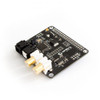

If you are looking for a case for HiFiBerry DAC+,Digi+ or AMP+ board - please check our own HighPi Case that was designed with HiFiBerry boards in mind. It's now in stock!
HiFiBerry's best selling DAC with powerful onboard Digial Signal Processing capabilities and digital transport capability!
Based on the company's proven DAC+ product which incorporates the highly regarded Burr-Brown chip, the DAC+DSP adds on-board Digital Signal Processing driven by the same powerful processor used on the Beocreate amplifier. Further enhancing the utility of this new board, TOSLINK (optical) and RCA connections for both input and output.
Features:
- Dedicated 192kHz/24bit high-quality Burr-Brown DAC
- Stereo analog output
- Stereo digital Toslink input and output (input up to 96kHz, output up to 192kHz)
300 MHz Digital Signal Process (can run up to 6144 instructions per sample) - High quality asynchronous sample rate converter that can upsample/downsample/mix audio sources - the function of our €˜+Pro' independent clocks, but managed by the DSP
- Onboard EEPROM allows to board to boot and run even without the Raspberry Pi
Use it as a DAC €˜on steroids'
The easiest thing to do is to use the DSP/DAC as a DAC for the Raspberry Pi to play back music - as you would do this with HiFiBerry's €œnormal€ DAC+ boards. But in this case, you have the added benefit of a high performance DSP to adjust for your particular needs.
Use it as a standalone DAC
For those of you who have an old CD player or TV to play back music just connect the TOSLink output of your CD player or TC to the TOSLink input of the board and get the analoge signal on the RCA output. You can even do this without the Raspberry Pi. However, you need to feed 5V to the board as it would normally be powered by the Raspberry Pi.
Use it as a digital transport
The DAC+ DSP can also pass digital signals from your Raspberry Pi to an existing DAC via the Toslink digital output, while applying DSP functions. Having both a DAC and transport on the same board is unique and very handy.
Upsample/downsample digital music sources
Many audiophiles fear sample rate conversions. There is a lot of discussions about €œbeing bit-perfect€Â. However, a it's a simple fact that basically all DACs on the market do not perform equally well on all sample rates. Some people might prefer 48kHz playback, others wants to use the highest available sample rate of 192kHz (that's the limit of SPDIF). Do you have any preferences? With different DSP settings, you can try by yourself to see what works best for you. The performance parameters of the integrated asynchronous sample rate converters (dynamics, distortions) are better than the analogue performance of your DAC. Don't be afraid to try it out.
Room equalization
The major challenges in audio playback isn't the electronics. While different components can have an impact on audio performance - there is one component that definitely will have a huge impact - the room that you're listening in. The same electronics and speakers can sound very different in different rooms. Not only the walls of a room, but every piece of furniture in it will reflect parts of the sound waves and absorb other parts. Especially in the low frequency range, where there is a lot of absorption which can create all kinds of problems. Some frequencies might be very loud, others might be almost inaudible. This is normal and you can't completely eliminate the effects of rooms acoustics. However, you can improve the performance of your setup. The easiest way to do this is to find room resonances and reduce the volume of the sound at these specific resonance frequencies. Sounds complicated? Luckily there are tools like REW that do a lot of the measurements an calculations for you already. They've already created a guide how to use REW with their DSP toolkit.
Change DSP parameters on the fly
You have some cool ideas to change the parameters of a DSP program on the fly? What about dynamic reduction that automatically gets activated at night? Yes, we all love high dynamics, but sometimes our neighbours don't. Or you want to use a different equalizer set for TV playback than for music playback? Everything is possible. The DSP can be programmed directly from the Raspberry Pi. You can change parameters can be done with simple command line tools.

